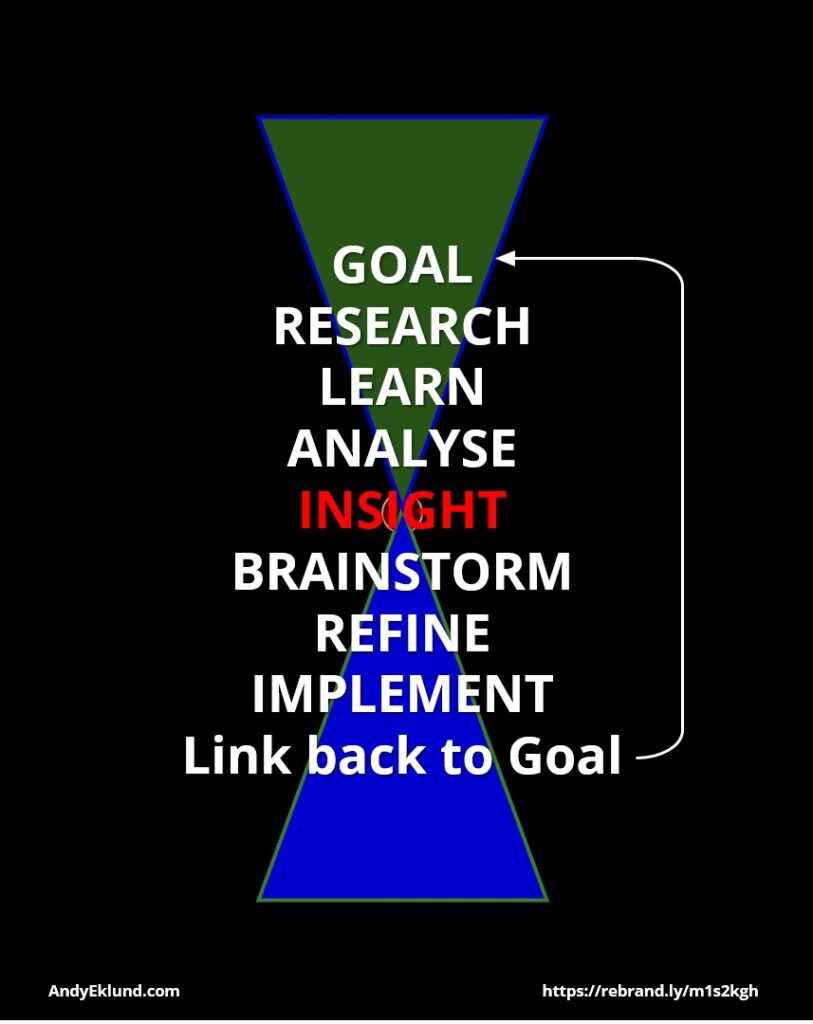To understand how people were creative at work, I spent time watching and interviewing clients and colleagues approach a typical assignment.
It was fascinating because everyone used a different system. Some were very specific (as if following a theory from a textbook) while others were more fluid and flexible (as if learnt by trial and error).
Regardless of how they approached their process, nearly everyone in the end followed the same basic system:
- Goal
- Research
- Learn
- Analyse
- Insight
- Brainstorm
- Refine
- Implement
- Linking back to #1 Goal
Do you see yourself in any of these steps when you’re trying to be creative at work?
1. They started with an objective or goal.
The goal helped them to understand the task at hand, know what they had to accomplish, and understand the expectations of their team leader or colleagues. Most of all, it gave them a due date (the T in ) so there was clarity in terms of when things needed to be done.
2. They conducted research.
They gathered information, by speaking to others, surfing the internet, or conducting or buying research. Some spoke to more people to confirm what they learnt, to see if it was relevant or applicable, and made sure they had a balance perspective both internally and externally.
3. They learned.
By gathering information, they expanded their knowledge. Some information was new to them. Some reinforced what they already knew. Other information challenged their assumptions, or made them change their opinions. Some information made them consider expanding their knowledge or perspective. This last point was important because it made them reconsider what they knew about what they knew.
4. They analyzed.
As they learnt, they made decisions about the quality of the information. Some information was right and important. Other information was not right but interesting. It pointed them in a different direction. Some information wasn’t helpful at all, or wrong, and oh well. In the end, they used the “good information” to move them one step closer to their goal. This analysis created wisdom, which in turn created something even more valuable …
5. They gained an insight.
Somewhere along the way, a momentous thing happened. Whether it was deliberate or unconscious, they uncovered a vital piece of information which reinforced the essence of the problem. Or, it completely changed what they understood about their knowledge. More often than not, several pieces of information coalesced into a critical understanding of the assignment or topic. They realised the information meant something useful, which in turn suggested action. They might even have had …
6. They formed an idea.
An ‘AHA!’ moment! This was the impetus for a possible solution to help them achieve the objective. They probably thought, ‘I should take this action.’ If they were particularly excited, they created another idea, then another. Some brought colleagues together to create even more ideas through brainstorming. They created as many ideas as possible. (Hello,!)
7. They sorted and refined.
Among all options, they eventually selected a few good ideas to hone into the best solution. Some ideas were merged together; others were refined by improving the better parts and removing the worse parts. Some conducted additional research to help make sure they perfected their idea in the right way.
8. They implemented.
The idea became action, which helped them achieve their objective, which addressed a problem (like John Bradfield) or fulfilled a need (like Albert Parkhouse). Either way, it linked them back to their first step. (See the Bradfield vs. Parkhouse reference here.)
9. They made sure their idea helped achieve the desired outcome.
If you could draw this thought process as a flow of shapes, you would get the Hourglass Figure which demonstrates the opposite and complementary nature of Strategic Thinking and Creative Thinking.
Here’s another way to think about being creative at work. The process outlined in this article is directly connected to something called The Information Chain, or by its scientific name, the DKIW Pyramid.
What other steps did you take to be creative at work? Please add your comments below.


No comment yet, add your voice below!